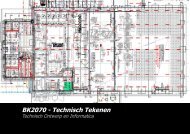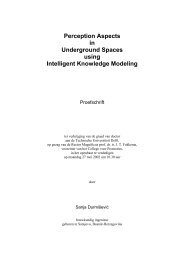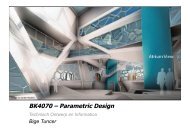Rapid prototyping - TOI
Rapid prototyping - TOI
Rapid prototyping - TOI
You also want an ePaper? Increase the reach of your titles
YUMPU automatically turns print PDFs into web optimized ePapers that Google loves.
<strong>Rapid</strong> <strong>prototyping</strong>CAD / lectureOctober 5, 20101TO&I Vermelding onderdeel organisatie
<strong>Rapid</strong> <strong>prototyping</strong><strong>Rapid</strong> <strong>prototyping</strong> is:• <strong>Rapid</strong> <strong>prototyping</strong> is an additive (layered) digital fabrication technology• Layers of material are added forming the final 3d physical model• The digital data of the virtual 3d model is divided in slices and manufactured in layers• They differ from other digital manufacturing techniques like milling and laser cutting which aresubtractive in natureCAD / lectureOctober 5, 20102TO&I Vermelding onderdeel organisatie
<strong>Rapid</strong> <strong>prototyping</strong>Main types of <strong>Rapid</strong> <strong>prototyping</strong> are:• Selective laser sintering (SLS) - Laser fuses plastic, metal or ceramic particles together.• Fused Deposition modelling (FDM) - Plastics or metal are melted and used as printfluid.• Stereo lithography (STL or SLA) - Laser cures the “fluid resin” in layers.• Laminated object manufacturing (LOM) - Layers of paper or plastic are cut and stacked.• 3D Printing (3DP) - Layers of powder are bound together by fluid from printerhead.CAD / lectureOctober 5, 20103TO&I Vermelding onderdeel organisatie
<strong>Rapid</strong> <strong>prototyping</strong>Main types of <strong>Rapid</strong> <strong>prototyping</strong> are:Selective laser sintering (SLS) Laser fuses plastic, metal or ceramic particles together.• Advantage a wide range of materials can be used.• Disadvantage the accuracy is depending on the particle size.CAD / lectureOctober 5, 20104TO&I Vermelding onderdeel organisatie
<strong>Rapid</strong> <strong>prototyping</strong>Main types of <strong>Rapid</strong> <strong>prototyping</strong> are:Fused Deposition modelling (FDM) Plastics or metal are melted and used as print fluid for layeredprinting.• Advantage is that several materials can be used with different strength and melting temperature.• Disadvantage is the limited detail in the printing process.CAD / lectureOctober 5, 20105TO&I Vermelding onderdeel organisatie
<strong>Rapid</strong> <strong>prototyping</strong>Main types of <strong>Rapid</strong> <strong>prototyping</strong> are:Stereo lithography (STL or SLA) Laser cures the liquid photopolymer in layers.• Advantage is the high accuracy of the models.• Disadvantage is the high machine costs and the limited amount of materials which can be used.CAD / lectureOctober 5, 20106TO&I Vermelding onderdeel organisatie
<strong>Rapid</strong> <strong>prototyping</strong>Main types of <strong>Rapid</strong> <strong>prototyping</strong> are:Laminated object manufacturing (LOM) Layers of paper or plastic are cut and stacked.• Advantage is the low costs of material and the large size of the object.• Disadvantage are the limited amount of materials which can be used.CAD / lectureOctober 5, 20107TO&I Vermelding onderdeel organisatie
<strong>Rapid</strong> <strong>prototyping</strong>Main types of <strong>Rapid</strong> <strong>prototyping</strong> are:3D Printing (3DP) Layers of powder are bound together by fluid from printer head.• Advantage is the low costs , ease of use and speed of the printing process.• Disadvantage are the limited amount of materials which can be used and the limited accuracy.CAD / lectureOctober 5, 20108TO&I Vermelding onderdeel organisatie
<strong>Rapid</strong> <strong>prototyping</strong>Main types of rapid <strong>prototyping</strong> difference:Used material:*Strength of the 3D model*Accuracy of the 3D model*Surface finish of the 3D model*Cost per printMachines:*Cost*Size of the machine*Hazardous environment?*Speed*Size of objectCAD / lectureOctober 5, 20109TO&I Vermelding onderdeel organisatie
<strong>Rapid</strong> <strong>prototyping</strong>The use of rapid <strong>prototyping</strong> techniques:• Design support• Basis for indirect manufacturing• Direct manufacturing (low volume)Advantages are:• The speed of making physical models in comparison with the traditional model making techniques.• The possible complexity of the models• The direct link with the digital design data• Testing design concepts or functionality of the object• Possibility of using the 3D models as a mould or a contra mould• Direct manufacturing of low volumesCAD / lectureOctober 5, 201010TO&I Vermelding onderdeel organisatie
<strong>Rapid</strong> <strong>prototyping</strong>3D printing – contour craftingLarge scale3d printingBehrokh Khoshnevis is a professor of Industrial & Systems Engineering and Civil & EnvironmentalEngineering USC11TO&I Vermelding onderdeel organisatie
<strong>Rapid</strong> <strong>prototyping</strong>The use of rapid <strong>prototyping</strong> techniques: Design supportVisual feedbackOctober 5, 201012TO&I Vermelding onderdeel organisatie
<strong>Rapid</strong> <strong>prototyping</strong>The use of rapid <strong>prototyping</strong> techniques: Design support3D model of the design - CommunicationOctober 5, 201013TO&I Vermelding onderdeel organisatie
<strong>Rapid</strong> <strong>prototyping</strong>The use of rapid <strong>prototyping</strong> techniques: Basis for indirect manufacturing<strong>Rapid</strong> <strong>prototyping</strong> of casts – low volume productionOctober 5, 201015TO&I Vermelding onderdeel organisatie
<strong>Rapid</strong> <strong>prototyping</strong>The use of rapid <strong>prototyping</strong> techniques: Basis for indirect manufacturing<strong>Rapid</strong> <strong>prototyping</strong> of contra mouldsOctober 5, 201016TO&I Vermelding onderdeel organisatie
<strong>Rapid</strong> <strong>prototyping</strong>The use of rapid <strong>prototyping</strong> techniques: Direct manufacturing3D printed CO2 filter for power plantOctober 5, 201017TO&I Vermelding onderdeel organisatie
<strong>Rapid</strong> <strong>prototyping</strong>The use of rapid <strong>prototyping</strong> techniques: Direct manufacturing3D printed soles of customized shoes for Olympic athletesOctober 5, 201018TO&I Vermelding onderdeel organisatie
<strong>Rapid</strong> <strong>prototyping</strong>3D printing at the facultyOctober 5, 201019TO&I Vermelding onderdeel organisatie
<strong>Rapid</strong> <strong>prototyping</strong>3D printing at the facultyThe Cam Lab has two 3D printers for students to use.The printers generates gypsum plaster modelsZ Corp 350 3D printerThe maximum sizes for the models are:20,3 x 25,4 x 20,3 cm (8 x 10 x 8 inch)Z Corp 510 color 3D printerThe maximum sizes for the models are:25,4 x 35,6 x 20,3 cm (10 x 14 x 8 inch)CAD / lectureOctober 5, 201020TO&I Vermelding onderdeel organisatie
<strong>Rapid</strong> <strong>prototyping</strong>3D printing at the facultyThe printers generates gypsum plaster modelsThe material is quite brittle and not suitable for supporting high loadsThe accuracy is 0.1 mmMinimum thickness of 3 mm for walls and floorsMinimum thickness of 1 mm for columns (thicker when higher)Minimum thickness of 3 mm for free-standing columnsEmbossments are already visible with only 0.1 mm differenceCAD / lectureOctober 5, 201021TO&I Vermelding onderdeel organisatie
<strong>Rapid</strong> <strong>prototyping</strong>3D printing at the facultySoftware:CAD (Maya-Rhino) – design of the 3D modelCAM (Zprint) – print software imports the 3D model and prints the imported 3D modelThe Zprint software imports files with extension of VRML or STLThe 3D model has to be a closed 3D polygon model for printingOctober 5, 201022TO&I Vermelding onderdeel organisatie
23TO&I Vermelding onderdeel organisatie





